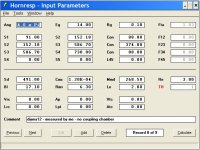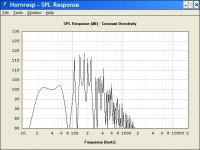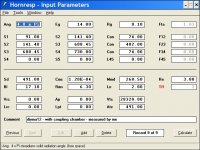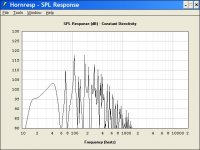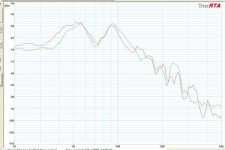Over in my Tapped Horn for Dummies thread* I discovered tapped horns are a lot more similar to bandpass boxes than I realized.
Here's some simulations showing a few tricks you can do with tapped horns, and it illustrates how similar they are.
In particular it shows a new feature of horn response, which allows you to include a coupling chamber to shape the response.
* http://www.diyaudio.com/forums/showthread.php?threadid=114340&goto=newpost
Here's some simulations showing a few tricks you can do with tapped horns, and it illustrates how similar they are.
In particular it shows a new feature of horn response, which allows you to include a coupling chamber to shape the response.
* http://www.diyaudio.com/forums/showthread.php?threadid=114340&goto=newpost
Here's the thiele small of the Diyma, which I measured personally after breaking in the driver:
Attached is a pic of the response, using the parameters from the previous post. It's getting 50watts in this sim.
* f(s)= 27.59 Hz
* R(e)= 3.77 Ohms
* Z(max)= 50.72 Ohms
* Q(ms)= 7.625
* Q(es)= 0.612
* Q(ts)= 0.567
* L(e)= 2.03 mH
Attached is a pic of the response, using the parameters from the previous post. It's getting 50watts in this sim.
* f(s)= 27.59 Hz
* R(e)= 3.77 Ohms
* Z(max)= 50.72 Ohms
* Q(ms)= 7.625
* Q(es)= 0.612
* Q(ts)= 0.567
* L(e)= 2.03 mH
Attachments
Here's where it gets fun. I take the exact same sub driver, in the same tapped horn, and add a coupling chamber. I also tweak the driver location using the tapped horn wizard. The overall volume is nearly the same, except the coupling chamber takes up a cubic foot. (That's the 28320cc in the VTC column)
Attachments
Here's the frequency response WITH a coupling chamber. First thing you'll notice is that it's dramatically tilted down. I actually did this on purpose. I haven't seen anyone put a tapped horn in a car, and the Diyma 12 is a good candidate. In a car you *want* the response to droop, as the car's cabin gain adds about 24db at 20hz, and 12db at 40hz. That's why small sealed subs sound so good in a car, and big vented boxes sound sluggish and boomy. The car's cabin gain ruins the flat response of a vented box, and augments the slowly decaying response of a sealed box.
But this tapped horn gives you the best of both worlds - the low excursion of a tapped horn, combined with a driver that can take some real abuse.
Once you add in cabin gain, the F3 of this monster will be around 15hz! And the power handling, thanks to the low excursion, will be downright absurd.
It could use a little tweaking, with a bit of work someone could easily make this fit in a smaller box, with even HIGHER power handling. You don't really NEED an F3 of 15hz in a car do you? Have fun!
But this tapped horn gives you the best of both worlds - the low excursion of a tapped horn, combined with a driver that can take some real abuse.
Once you add in cabin gain, the F3 of this monster will be around 15hz! And the power handling, thanks to the low excursion, will be downright absurd.
It could use a little tweaking, with a bit of work someone could easily make this fit in a smaller box, with even HIGHER power handling. You don't really NEED an F3 of 15hz in a car do you? Have fun!
Attachments
Lot of talk as of late on www.termpro.com about tapped horns. Being the home site of dB Drag Racing, we are all about bass over there.
I just don't know if you could physically fit a 30 hertz tapped horn into a car trunk.
I just don't know if you could physically fit a 30 hertz tapped horn into a car trunk.
winslow said:Lot of talk as of late on www.termpro.com about tapped horns. Being the home site of dB Drag Racing, we are all about bass over there.
I just don't know if you could physically fit a 30 hertz tapped horn into a car trunk.
Well once you recognize that a tapped horn is anything BUT a horn, it's really just a deviant bandpass box, life gets a lot easier!
Once you accept that, you'll see that you can make tapped horns preposterously small. It's really just a dual reflex bandpass box, with the advantage that you can tweak the response and the excursion a heck of a lot more than you can with a conventional bandpass box. Yay for the tapped horn wizard.
For example, I crunched the numbers on the Diyma, and came up with a tapped horn that's SMALLER than a bandpass. The bandpass actually as more output, but the tapped horns big advantage is less port turbulence, and excursion that's a LOT less in the passband. I'll post details, cool?
Patrick Bateman said:In a car you *want* the response to droop, as the car's cabin gain adds about 24db at 20hz, and 12db at 40hz. That's why small sealed subs sound so good in a car, and big vented boxes sound sluggish and boomy. The car's cabin gain ruins the flat response of a vented box, and augments the slowly decaying response of a sealed box.
Hi Patrick,
I've been doing a fair bit of measuring over the last couple months as I'm in the middle of installing my stereos in my commuter hatchback and my weekend suv. In both vehicles a sealed box does not measure like the car audio sites would have us believe.
Rob.
RobWells said:
Hi Patrick,
I've been doing a fair bit of measuring over the last couple months as I'm in the middle of installing my stereos in my commuter hatchback and my weekend suv. In both vehicles a sealed box does not measure like the car audio sites would have us believe.
Rob.
I read your thread about that a few months ago. Here's what Rob is referring to:
http://www.diyaudio.com/forums/showthread.php?s=&threadid=115522&perpage=25&highlight=&pagenumber=2
RobWells said:
Hi Patrick,
I've been doing a fair bit of measuring over the last couple months as I'm in the middle of installing my stereos in my commuter hatchback and my weekend suv. In both vehicles a sealed box does not measure like the car audio sites would have us believe.
Rob.
Andy Wehmeyer over at JBL posted some cabin gain measurements that his company did. Based on JBL's data, it looks like my numbers were off, but not by much. JBL shows about 15db extra output at 40hz, and 25db at 20hz. Here's the pic:
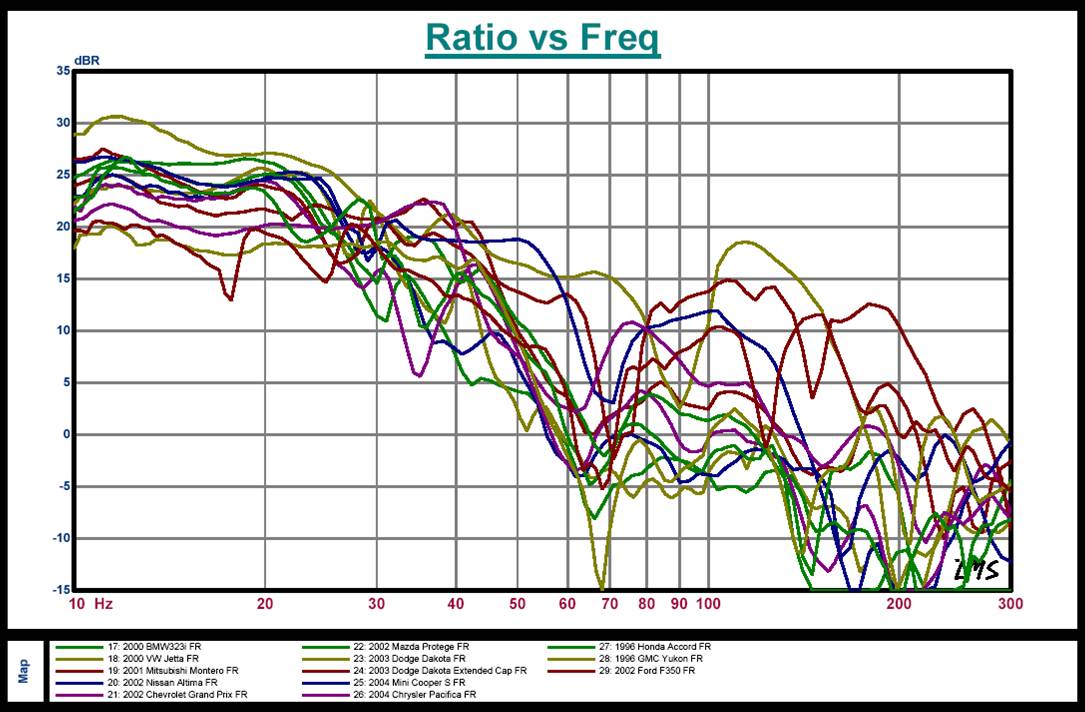
RobWells said:That doesn't mention my commuter car - here's a plot of the 'xt10' sub mentioned in that thread in this small hatchback.
That's pretty consistent with JBL's data. The notch in your car is at 60hz, instead of 70, and there's clearly tons of cabin gain kicking in at 50hz.
Funnily enough my infinitys are part of jbl's parent company (Harman int) and their data sheet shows much the same plot as that you just posted. (as does the data sheet on my JBL gt4'S that are going in the hatchback)
I suggest you measure for yourself to get a 'real world' measurement as they just aren't so pretty.
Rob.
I suggest you measure for yourself to get a 'real world' measurement as they just aren't so pretty.
Rob.
Patrick Bateman said:
That's pretty consistent with JBL's data. The notch in your car is at 60hz, instead of 70, and there's clearly tons of cabin gain kicking in at 50hz.
I'd say it isn't consistent at all with jbl's data - they show a general rise in spl below 50Hz, whereas my graph is dropping below 50Hz.
Rob.
The only thing I can possibly think that explains the difference could be that both my vehicles are fairly old ('93 and '96) so probably not as 'gas tight' as the vehicles measured by JBL. Maybe if I spent a fortune on new door and boot (trunk) seals all round I'd get more boost in the lowest bass.
Rob.
Rob.
This thread makes the perfect place to ask about (tapped)horn loading and cabin gain. More specifically, I've seen the AutoTuba plots after googleing them, but they all seem to be taken *inside* the car and even there it still falls off at lower freq.
I've read somewhere that car horns go lower/louder with the doors open because there is less backpressure on the horn mouth. This concurrs with the lower cutoff point of my corner horn here at home when I open the large porch windows. (Could also be by reduced room nodes.)
Since a Tapped Horn is a lot less dependant on corner loading, I wonder if this windows-effect would also be for a TH in a car?
I'm just pondering about what to put in my trunck when I do an upgrade next spring.
I've read somewhere that car horns go lower/louder with the doors open because there is less backpressure on the horn mouth. This concurrs with the lower cutoff point of my corner horn here at home when I open the large porch windows. (Could also be by reduced room nodes.)
Since a Tapped Horn is a lot less dependant on corner loading, I wonder if this windows-effect would also be for a TH in a car?
I'm just pondering about what to put in my trunck when I do an upgrade next spring.
Cordraconis said:This thread makes the perfect place to ask about (tapped)horn loading and cabin gain. More specifically, I've seen the AutoTuba plots after googleing them, but they all seem to be taken *inside* the car and even there it still falls off at lower freq.
I've read somewhere that car horns go lower/louder with the doors open because there is less backpressure on the horn mouth. This concurrs with the lower cutoff point of my corner horn here at home when I open the large porch windows. (Could also be by reduced room nodes.)
Since a Tapped Horn is a lot less dependant on corner loading, I wonder if this windows-effect would also be for a TH in a car?
I'm just pondering about what to put in my trunck when I do an upgrade next spring.
I cloned an autotuba and had it in my car for a few months. It was a LOT of fun, possibly one of the funnest car audio projects I've ever done. After a while I got sick of it, because it didn't go deep enough. It has a ridiculous amount of 'slam' in the upper bass, around 80-100hz, but the low bass doesn't have the same impact you get from a pair of 12s. And this is no surprise, as far as I can see, it's basically an eight in a sealed box below the horn cutoff, which is quite high. I've got to hand it to Bill Fitzmaurice, his design raises the power handling of the driver in a huge way. I was feeding it something like 500 watts IIRC. I believe it's rated for 100 watts, and it's from MCM, so it's probably more like 50 watts IRL
As for corner loading a sub in a car, I really doubt it would make a worthwhile difference. I tried this myself with the autotuba clone I made, designing it so that mouth exited through the passthrough of the rear seats. The idea was that the rear deck would extend the mouth flare. When I measured it in car, my measurements didn't indicate that the rear deck was helping out the low end at all.
One thing that DID make a difference was opening up the rear seats - there's this myth that bass will magically travel through the rear seats, but this isn't true. Pushing the seats forward changed the frequency response quite dramatically (for the better.) Admittedly, most of the improvements were in the upper bass, so if your sub is only covering 20-60hz, don't bother.
I tried half a dozen different designs using a Diyma12 yesterday, and kept running into issues. Basically I was just getting TOO MUCH low bass. Every design I tried wound up playing into the teens once you factored in cabin gain, and the box size was getting hella huge.
Danley made some comments on my other thread that made me think that I should try a woofer with a higher FS. So I've thrown together a couple of designs using an Audax HT240G0.
Here's a pic of the response in a single reflex bandpass tuned to 63HZ:
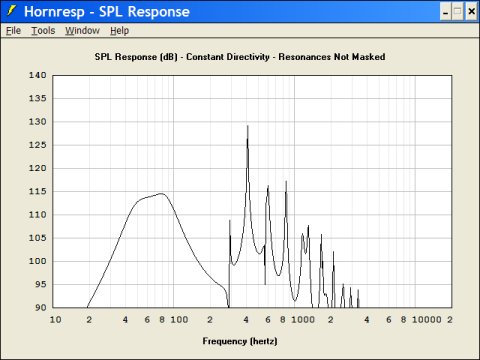
It's being fed 1000 watts; with 25db of cabin gain at 20hz and 15db of cabin gain at 40hz, it will be basically flat to 20hz inside a car.
The problem is the excursion, shown here. I'm betting some tapped horn goodness could be used to improve the excursion, at the expense of a larger enclosure.
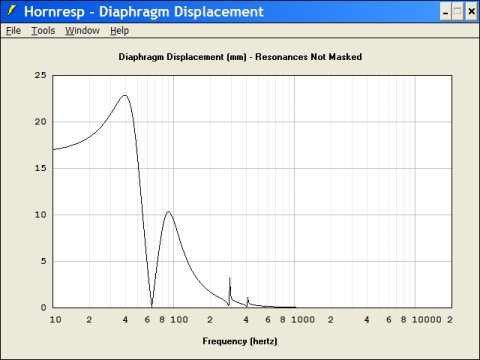
Here are the parameters. I measured the woofer myself. It's an isobaric pair of Audax HT240G0 woofers in a single reflex bandpass. The rear chamber is 34.5L, the front is 18.7L. There are a pair of three inch vents, measuring 25.68cm in length. Two three inch vents are just a bit better than a single 4" vent; their big advantage is that the pipe modes are much higher in frequency.
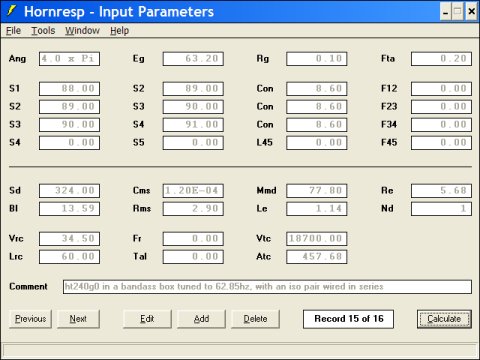
Of course I am a complete cheapskate - you can get this woofer for a whopping $28 at parts express.
http://www.partsexpress.com/pe/showdetl.cfm?&Partnumber=296-138
I have something like eight of them in the garage, the build quality is really nice. I purchased them for a dipole project that I abandoned when I bought my Summas. Here's the specs, measured by yours truly. They're quite close to what Audax advertises.
* f(s)= 51.14 Hz
* R(e)= 2.84 Ohms
* Z(max)= 34.69 Ohms
* Q(ms)= 8.963
* Q(es)= 0.800
* Q(ts)= 0.735
* L(e)= 0.57 mH
Danley made some comments on my other thread that made me think that I should try a woofer with a higher FS. So I've thrown together a couple of designs using an Audax HT240G0.
Here's a pic of the response in a single reflex bandpass tuned to 63HZ:

It's being fed 1000 watts; with 25db of cabin gain at 20hz and 15db of cabin gain at 40hz, it will be basically flat to 20hz inside a car.
The problem is the excursion, shown here. I'm betting some tapped horn goodness could be used to improve the excursion, at the expense of a larger enclosure.

Here are the parameters. I measured the woofer myself. It's an isobaric pair of Audax HT240G0 woofers in a single reflex bandpass. The rear chamber is 34.5L, the front is 18.7L. There are a pair of three inch vents, measuring 25.68cm in length. Two three inch vents are just a bit better than a single 4" vent; their big advantage is that the pipe modes are much higher in frequency.

Of course I am a complete cheapskate - you can get this woofer for a whopping $28 at parts express.
http://www.partsexpress.com/pe/showdetl.cfm?&Partnumber=296-138
I have something like eight of them in the garage, the build quality is really nice. I purchased them for a dipole project that I abandoned when I bought my Summas. Here's the specs, measured by yours truly. They're quite close to what Audax advertises.
* f(s)= 51.14 Hz
* R(e)= 2.84 Ohms
* Z(max)= 34.69 Ohms
* Q(ms)= 8.963
* Q(es)= 0.800
* Q(ts)= 0.735
* L(e)= 0.57 mH
- Status
- This old topic is closed. If you want to reopen this topic, contact a moderator using the "Report Post" button.
- Home
- Loudspeakers
- Subwoofers
- Tapped Horn meets Bandpass Sub
